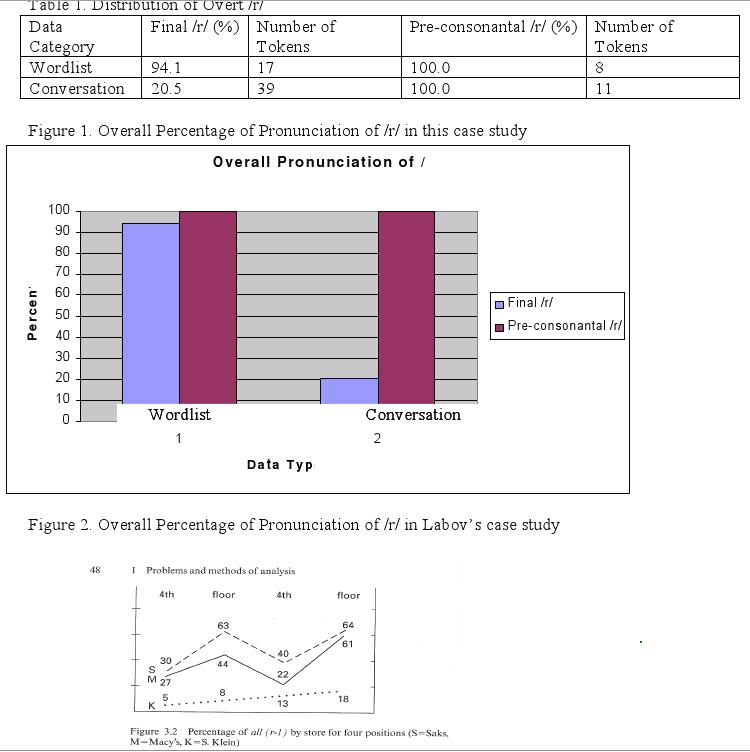A Case Study on New York City R-lessness – A New Pattern of Phonological Conditioning
R-lessness in New York City has been analyzed as decreasing across all socioeconomic classes in preconsonantal and word-final contexts, due to change from above (cf. Labov 1963, Fowler 1986) . However, instead of respectively decreasing categorically in the previously analyzed contexts, r- lessness in this case study does not occur in preconsonantal environments, but is categorical in word-final contexts. This is a new and surprising pattern in New York City rhoticity, and is contrasted with previous studies. Initially this research was conducted to support the findings of William Labov’s 1963 department store study. After analyzing the data however it now serves as an extension of his previous work.
William Labov’s 1963 department store study found the phonological presence of final and preconsonantal /r/ to increase with speakers of a higher socioeconomic status, represented by the department store workers of S. Klein, Macy’s, and Saks Fifth Avenue. This trend does not separate final from preconsonantal /r/ tokens, and r-lessness is in fact even more likely in preconsonantal conditions. When Fowler conducted a restudy in 1986, her findings were almost identical to Labov’s 1966 department store study, except with a higher rate of r-fullness and thus less r-lessness due to ongoing
change from above. This consistency showed that phonological conditioning for non-rhotic accents in New York City had not changed, only that speakers were consistently more r-ful across the board. Current studies on r-lessness in New York City describe it being differentiated by ethnicity and identity (Becker 2009) but not by the phonological context as evidenced by this case study.
This study analyzed the rhoticity of a middle class, forty-four year old business woman who was raised in Brooklyn, and has been a lifelong resident of New York City. The phonological presence of /r/ was analyzed in both casual and formal speech in the context of a conversation and wordlist respectively. A video recorder was used to document such language. The speaker was not informed beforehand of the recording in order to prevent her awareness from skewing the data since conscious speech tends to be more formal. The recorder was placed out of the speaker’s visual field and permission was granted retroactively. Once the data was gathered, final and preconsonantal /r/ tokens were separately analyzed within each style. As seen in Table 1, the preconsonantal /r/ words were 100 % r-ful within casual and emphatic speech. This speaker showed no distinction between her pronunciation for relaxed and formal environmental settings. In comparison, the final /r/ tokens contained stratification between the wordlist and conversation data; the speaker was 94.1 % r-full for the wordlist tokens and only 20.5 % r-ful for the conversational tokens. As expected, she was more r-ful in formal speech in comparison to the casual speech. The main discrepancy between this study and Labov’s ground laying research is the presence of pre-consonantal /r/ in casual and formal speech. A comparison of Figure 1 and Figure 2 graphically
demonstrates this.
In this case study, we found that style-shifting in r-lessness only occurred in word-final position; preconsonantal /r/ words were categorically r-ful. Such a pattern has not been observed in previous New York City rhoticity studies (cf. Labov 1966, Fowler 1986 & Becker 2009). There are two possible considerations to be made. If further research indicates that this pattern is unique to one individual, this case-study can provide information as to how language change begins in society. However, if multiple speakers have a similar pattern, then there are two possibilities. The first is that this pattern has been
present all along in some speakers of the New York City dialect, but as of yet has been undocumented. The second possibility is that this case study is evidence of a language change that has occurred or is occurring, and that the conditioning of New York City rhoticity for some speakers is undergoing a categorical split. This case study leads to many further questions, such as where the dialect boundaries are between traditional New York City rhoticity and this new pattern, how speakers acquired this pattern in contrast to traditional rhoticity, and how language variation and contact results in complex changes in phonological conditioning.
More data will be collected to determine the statistical significance of the distribution of /r/ in the speaker’s phonological system. The preliminary data will continue to be investigated in order to further support the conclusion we are drawing from the data. The data collected will be from individuals similar to the speaker in this case study in order to control for outside variables that can produce changes in a person’s phonological system.
